Experimental and Process Modelling Investigation of the Hydrogen Generation from Formic Acid Decomposition Using a Pd/Zn Catalyst
Abstract
:1. Introduction
2. Materials and Methods
2.1. Materials and Chemicals
2.2. Catalyst Preparation
2.3. Catalytic Tests
2.4. Catalyst Characterisation
- XPS
- TEM
2.5. Modelling Methodology
3. Results and Discussion
3.1. Catalyst Characterisation
3.1.1. TEM Results
3.1.2. XPS Results
3.2. Modelling Results
3.2.1. Batch Reactor Model Validation
3.2.2. Pd/Zn vs. Pd/C Catalyst
4. Conclusions
Author Contributions
Funding
Institutional Review Board Statement
Informed Consent Statement
Data Availability Statement
Acknowledgments
Conflicts of Interest
References
- Choi, B.-S.; Song, J.; Song, M.; Goo, B.S.; Lee, Y.W.; Kim, Y.; Yang, H.; Han, S.W. Core–shell engineering of Pd–Ag bimetallic catalysts for efficient hydrogen production from formic acid decomposition. ACS Catal. 2018, 9, 819–826. [Google Scholar] [CrossRef]
- Barlocco, I.; Capelli, S.; Lu, X.; Tumiati, S.; Dimitratos, N.; Roldan, A.; Villa, A. Role of defects in carbon materials during metal-free formic acid dehydrogenation. Nanoscale 2020, 12, 22768–22777. [Google Scholar] [CrossRef] [PubMed]
- Bulushev, D.A.; Zacharska, M.; Beloshapkin, S.; Guo, Y.; Yuranov, I. Catalytic properties of PdZn/ZnO in formic acid decomposition for hydrogen production. Appl. Catal. A Gen. 2018, 561, 96–103. [Google Scholar] [CrossRef]
- Sanchez, F.; Alotaibi, M.H.; Motta, D.; Chan-Thaw, C.E.; Rakotomahevitra, A.; Tabanelli, T.; Roldan, A.; Hammond, C.; He, Q.; Davies, T. Hydrogen production from formic acid decomposition in the liquid phase using Pd nanoparticles supported on CNFs with different surface properties. Sustain. Energy Fuels 2018, 2, 2705–2716. [Google Scholar] [CrossRef] [Green Version]
- Sanchez, F.; Motta, D.; Roldan, A.; Hammond, C.; Villa, A.; Dimitratos, N. Hydrogen generation from additive-free formic acid decomposition under mild conditions by Pd/C: Experimental and DFT studies. Top. Catal. 2018, 61, 254–266. [Google Scholar] [CrossRef] [PubMed] [Green Version]
- Sneka-Płatek, O.; Kaźmierczak, K.; Jędrzejczyk, M.; Sautet, P.; Keller, N.; Michel, C.; Ruppert, A.M. Understanding the influence of the composition of the AgPd catalysts on the selective formic acid decomposition and subsequent levulinic acid hydrogenation. Int. J. Hydrogen Energy 2020, 45, 17339–17353. [Google Scholar] [CrossRef]
- Bao, S.; Liu, H.; Liu, Y.; Yang, W.; Wang, Y.; Yu, Y.; Sun, Y.; Li, K. Amino-functionalized graphene oxide-supported networked Pd–Ag nanowires as highly efficient catalyst for reducing Cr (VI) in industrial effluent by formic acid. Chemosphere 2020, 257, 127245. [Google Scholar] [CrossRef]
- Qin, X.; Li, H.; Xie, S.; Li, K.; Jiang, T.; Ma, X.-Y.; Jiang, K.; Zhang, Q.; Terasaki, O.; Wu, Z. Mechanistic analysis-guided Pd-based catalysts for efficient hydrogen production from formic acid dehydrogenation. ACS Catal. 2020, 10, 3921–3932. [Google Scholar] [CrossRef]
- Kim, Y.; Kim, S.-h.; Ham, H.C.; Kim, D.H. Mechanistic insights on aqueous formic acid dehydrogenation over Pd/C catalyst for efficient hydrogen production. J. Catal. 2020, 389, 506–516. [Google Scholar] [CrossRef]
- Alvear, M.; Aho, A.; Simakova, I.L.; Grénman, H.; Salmi, T.; Murzin, D.Y. Aqueous phase reforming of alcohols over a bimetallic Pt-Pd catalyst in the presence of formic acid. Chem. Eng. J. 2020, 398, 125541. [Google Scholar] [CrossRef]
- Dai, H.; Xia, B.; Wen, L.; Du, C.; Su, J.; Luo, W.; Cheng, G. Synergistic catalysis of AgPd@ ZIF-8 on dehydrogenation of formic acid. Appl. Catal. B Environ. 2015, 165, 57–62. [Google Scholar] [CrossRef]
- Tong, F.; Lou, Z.; Liang, X.; Ma, F.; Chen, W.; Wang, Z.; Liu, Y.; Wang, P.; Cheng, H.; Dai, Y. Plasmon-induced dehydrogenation of formic acid on Pd-dotted Ag@ Au hexagonal nanoplates and single-particle study. Appl. Catal. B Environ. 2020, 277, 119226. [Google Scholar] [CrossRef]
- Gao, S.-T.; Liu, W.; Feng, C.; Shang, N.-Z.; Wang, C. A Ag–Pd alloy supported on an amine-functionalized UiO-66 as an efficient synergetic catalyst for the dehydrogenation of formic acid at room temperature. Catal. Sci. Technol. 2016, 6, 869–874. [Google Scholar] [CrossRef]
- Yang, L.; Hua, X.; Su, J.; Luo, W.; Chen, S.; Cheng, G. Highly efficient hydrogen generation from formic acid-sodium formate over monodisperse AgPd nanoparticles at room temperature. Appl. Catal. B Environ. 2015, 168, 423–428. [Google Scholar] [CrossRef]
- Lv, Q.; Feng, L.; Hu, C.; Liu, C.; Xing, W. High-quality hydrogen generated from formic acid triggered by in situ prepared Pd/C catalyst for fuel cells. Catal. Sci. Technol. 2015, 5, 2581–2584. [Google Scholar] [CrossRef]
- Navlani-García, M.; Martis, M.; Lozano-Castello, D.; Cazorla-Amorós, D.; Mori, K.; Yamashita, H. Investigation of Pd nanoparticles supported on zeolites for hydrogen production from formic acid dehydrogenation. Catal. Sci. Technol. 2015, 5, 364–371. [Google Scholar] [CrossRef] [Green Version]
- Sanchez, F.; Motta, D.; Bocelli, L.; Albonetti, S.; Roldan, A.; Hammond, C.; Villa, A.; Dimitratos, N. Investigation of the catalytic performance of Pd/CNFs for hydrogen evolution from additive-free formic acid decomposition. J. Carbon Res. 2018, 4, 26. [Google Scholar] [CrossRef] [Green Version]
- Barlocco, I.; Capelli, S.; Zanella, E.; Chen, X.; Delgado, J.J.; Roldan, A.; Dimitratos, N.; Villa, A. Synthesis of palladium-rhodium bimetallic nanoparticles for formic acid dehydrogenation. J. Energy Chem. 2021, 52, 301–309. [Google Scholar] [CrossRef]
- Sanchez, F.; Bocelli, L.; Motta, D.; Villa, A.; Albonetti, S.; Dimitratos, N. Preformed Pd-Based Nanoparticles for the Liquid Phase Decomposition of Formic Acid: Effect of Stabiliser, Support and Au–Pd Ratio. Appl. Sci. 2020, 10, 1752. [Google Scholar] [CrossRef] [Green Version]
- Bhalothia, D.; Huang, T.-H.; Chou, P.-H.; Chen, P.-C.; Wang, K.-W.; Chen, T.-Y. CO-Reductive and O 2-Oxidative Annealing Assisted Surface Restructure and Corresponding Formic Acid Oxidation Performance of PdPt and PdRuPt Nanocatalysts. Sci. Rep. 2020, 10, 8457. [Google Scholar] [CrossRef]
- Bhalothia, D.; Huang, T.-H.; Chou, P.-H.; Wang, K.-W.; Chen, T.-Y. Promoting formic acid oxidation performance of Pd nanoparticles via Pt and Ru atom mediated surface engineering. RSC Adv. 2020, 10, 17302–17310. [Google Scholar] [CrossRef]
- Santos, J.L.; Megías-Sayago, C.; Ivanova, S.; Centeno, M.Á.; Odriozola, J.A. Structure-sensitivity of formic acid dehydrogenation reaction over additive-free Pd NPs supported on activated carbon. Chem. Eng. J. 2020, 420, 127641. [Google Scholar] [CrossRef]
- Carrales-Alvarado, D.; Dongil, A.; Fernández-Morales, J.; Fernández-García, M.; Guerrero-Ruiz, A.; Rodríguez-Ramos, I. Selective hydrogen production from formic acid decomposition over Mo carbides supported on carbon materials. Catal. Sci. Technol. 2020, 10, 6790–6799. [Google Scholar] [CrossRef]
- Wang, X.; Qi, G.-W.; Tan, C.-H.; Li, Y.-P.; Guo, J.; Pang, X.-J.; Zhang, S.-Y. Pd/C nanocatalyst with high turnover frequency for hydrogen generation from the formic acid–formate mixtures. Int. J. Hydrogen Energy 2014, 39, 837–843. [Google Scholar] [CrossRef]
- Sun, Q.; Chen, B.W.; Wang, N.; He, Q.; Chang, A.; Yang, C.M.; Asakura, H.; Tanaka, T.; Hülsey, M.J.; Wang, C.H. Zeolite-Encaged Pd–Mn Nanocatalysts for CO2 Hydrogenation and Formic Acid Dehydrogenation. Angew. Chem. 2020, 132, 20358–20366. [Google Scholar] [CrossRef]
- Wei, R.-L.; Huang, M.; Lan, B.; Wang, C.-N.; Wang, Q.-L.; Yang, Y.-Y. Efficient decomposition of formic acid into hydrogen on Pd nanoparticles anchored in amine-pyridine polymer networks without extra additives at ambient condition. Int. J. Hydrogen Energy 2021, 46, 8469–8476. [Google Scholar] [CrossRef]
- Biswas, S.S.; Tandrapadu, M.S.; Abinaya, E.; Eswaramoorthy, M. Deciphering the role of amine in amino silane-functionalized Pd/rGO catalyst for formic acid decomposition at room temperature. Bull. Mater. Sci. 2020, 43, 302. [Google Scholar] [CrossRef]
- Wang, Z.; Liang, S.; Meng, X.; Mao, S.; Lian, X.; Wang, Y. Ultrasmall PdAu Alloy Nanoparticles Anchored on Amine-functionalized Hierarchically Porous Carbon as Additive-free Catalysts for Highly Efficient Dehydrogenation of Formic Acid. Appl. Catal. B Environ. 2021, 291, 120140. [Google Scholar] [CrossRef]
- Fiorio, J.L.; Araujo, T.P.; Barbosa, E.C.; Quiroz, J.; Camargo, P.H.; Rudolph, M.; Hashmi, A.S.K.; Rossi, L.M. Gold-amine cooperative catalysis for reductions and reductive aminations using formic acid as hydrogen source. Appl. Catal. B Environ. 2020, 267, 118728. [Google Scholar] [CrossRef]
- Ma, C.; Duan, J.; Fu, Y.; Chang, J. Hydrogen production from additive-free formic acid over highly active metal organic frameworks-supported palladium-based catalysts. Int. J. Hydrogen Energy 2021, 46, 5259–5269. [Google Scholar] [CrossRef]
- Dai, H.; Cao, N.; Yang, L.; Su, J.; Luo, W.; Cheng, G. AgPd nanoparticles supported on MIL-101 as high performance catalysts for catalytic dehydrogenation of formic acid. J. Mater. Chem. A 2014, 2, 11060–11064. [Google Scholar] [CrossRef]
- Mori, K.; Dojo, M.; Yamashita, H. Pd and Pd–Ag nanoparticles within a macroreticular basic resin: An efficient catalyst for hydrogen production from formic acid decomposition. ACS Catal. 2013, 3, 1114–1119. [Google Scholar] [CrossRef]
- Mori, K.; Tanaka, H.; Dojo, M.; Yoshizawa, K.; Yamashita, H. Synergic catalysis of PdCu alloy nanoparticles within a macroreticular basic resin for hydrogen production from formic acid. Chem. A Eur. J. 2015, 21, 12085–12092. [Google Scholar] [CrossRef]
- Mori, K.; Naka, K.; Masuda, S.; Miyawaki, K.; Yamashita, H. Palladium copper chromium ternary nanoparticles constructed in situ within a basic resin: Enhanced activity in the dehydrogenation of formic acid. ChemCatChem 2017, 9, 3456–3462. [Google Scholar] [CrossRef] [Green Version]
- Yao, M.; Ye, Y.; Chen, H.; Zhang, X. Porous carbon supported Pd as catalysts for boosting formic acid dehydrogenation. Int. J. Hydrogen Energy 2020, 45, 17398–17409. [Google Scholar] [CrossRef]
- Ding, T.-Y.; Zhao, Z.-G.; Ran, M.-F.; Yang, Y.-Y. Superior activity of Pd nanoparticles confined in carbon nanotubes for hydrogen production from formic acid decomposition at ambient temperature. J. Colloid Interface Sci. 2019, 538, 474–480. [Google Scholar] [CrossRef] [PubMed]
- Boddien, A.; Loges, B.; Junge, H.; Gärtner, F.; Noyes, J.R.; Beller, M. Continuous hydrogen generation from formic acid: Highly active and stable ruthenium catalysts. Adv. Synth. Catal. 2009, 351, 2517–2520. [Google Scholar] [CrossRef]
- Majewski, A.; Morris, D.J.; Kendall, K.; Wills, M. A Continuous-Flow Method for the Generation of Hydrogen from Formic Acid. ChemSusChem 2010, 3, 431–434. [Google Scholar] [CrossRef]
- Sponholz, P.; Mellmann, D.; Junge, H.; Beller, M. Towards a practical setup for hydrogen production from formic acid. ChemSusChem 2013, 6, 1172–1176. [Google Scholar] [CrossRef]
- Caiti, M.; Padovan, D.; Hammond, C. Continuous production of hydrogen from formic acid decomposition over heterogeneous nanoparticle catalysts: From batch to continuous flow. ACS Catal. 2019, 9, 9188–9198. [Google Scholar] [CrossRef]
- Hafeez, S.; Aristodemou, E.; Manos, G.; Al-Salem, S.; Constantinou, A. Computational fluid dynamics (CFD) and reaction modelling study of bio-oil catalytic hydrodeoxygenation in microreactors. React. Chem. Eng. 2020, 5, 1083–1092. [Google Scholar] [CrossRef]
- Hafeez, S.; Aristodemou, E.; Manos, G.; Al-Salem, S.; Constantinou, A. Modelling of packed bed and coated wall microreactors for methanol steam reforming for hydrogen production. RSC Adv. 2020, 10, 41680–41692. [Google Scholar] [CrossRef]
- Hafeez, S.; Sanchez, F.; Al-Salem, S.M.; Villa, A.; Manos, G.; Dimitratos, N.; Constantinou, A. Decomposition of Additive-Free Formic Acid Using a Pd/C Catalyst in Flow: Experimental and CFD Modelling Studies. Catalysts 2021, 11, 341. [Google Scholar] [CrossRef]
- Hafeez, S.; Mahmood, S.; Aristodemou, E.; Al-Salem, S.M.; Manos, G.; Constantinou, A. Process Simulation Modelling of the Catalytic Hydrodeoxy-genation of 4-Propylguaiacol in Microreactors. Fuels 2021, 3, 16. [Google Scholar] [CrossRef]
- Renon, H.; Prausnitz, J.M. Local compositions in thermodynamic excess functions for liquid mixtures. AIChE J. 1968, 14, 135–144. [Google Scholar] [CrossRef]
- Juliá, J.A.; Barrero, C.R.; Corso, M.E.; del Carmen Grande, M.; Marschoff, C.M. On the application of the NRTL method to ternary (liquid + liquid) equilibria. J. Chem. Thermodyn. 2005, 37, 437–443. [Google Scholar] [CrossRef]
- Bulushev, D.A.; Beloshapkin, S.; Ross, J.R. Hydrogen from formic acid decomposition over Pd and Au catalysts. Catal. Today 2010, 154, 7–12. [Google Scholar] [CrossRef]
- Ting, S.-W.; Hu, C.; Pulleri, J.K.; Chan, K.-Y. Heterogeneous catalytic generation of hydrogen from formic acid under pressurized aqueous conditions. Ind. Eng. Chem. Res. 2012, 51, 4861–4867. [Google Scholar] [CrossRef]
- Liao, M.; Hu, Q.; Zheng, J.; Li, Y.; Zhou, H.; Zhong, C.-J.; Chen, B.H. Pd decorated Fe/C nanocatalyst for formic acid electrooxidation. Electrochim. Acta 2013, 111, 504–509. [Google Scholar] [CrossRef]
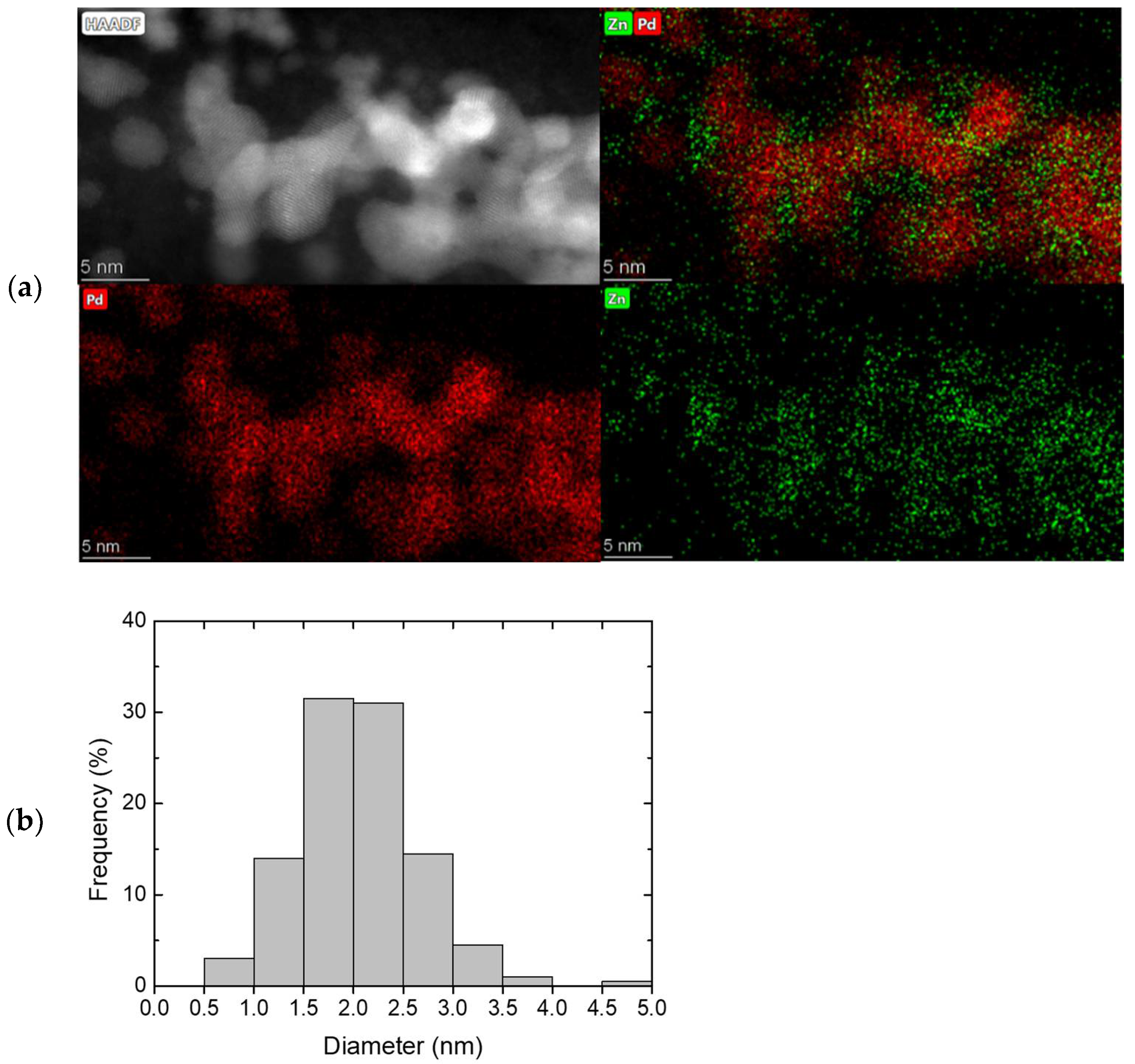
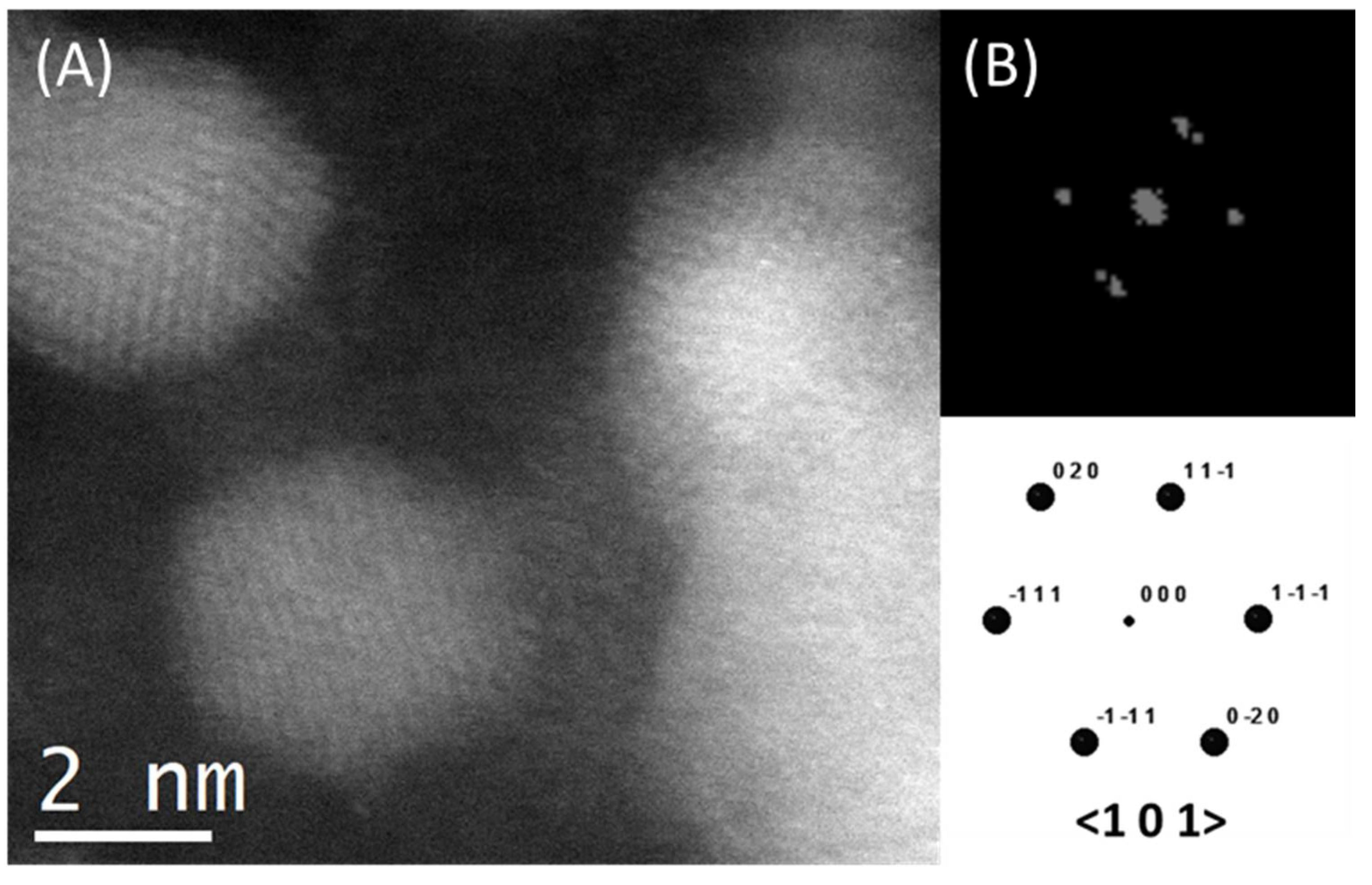
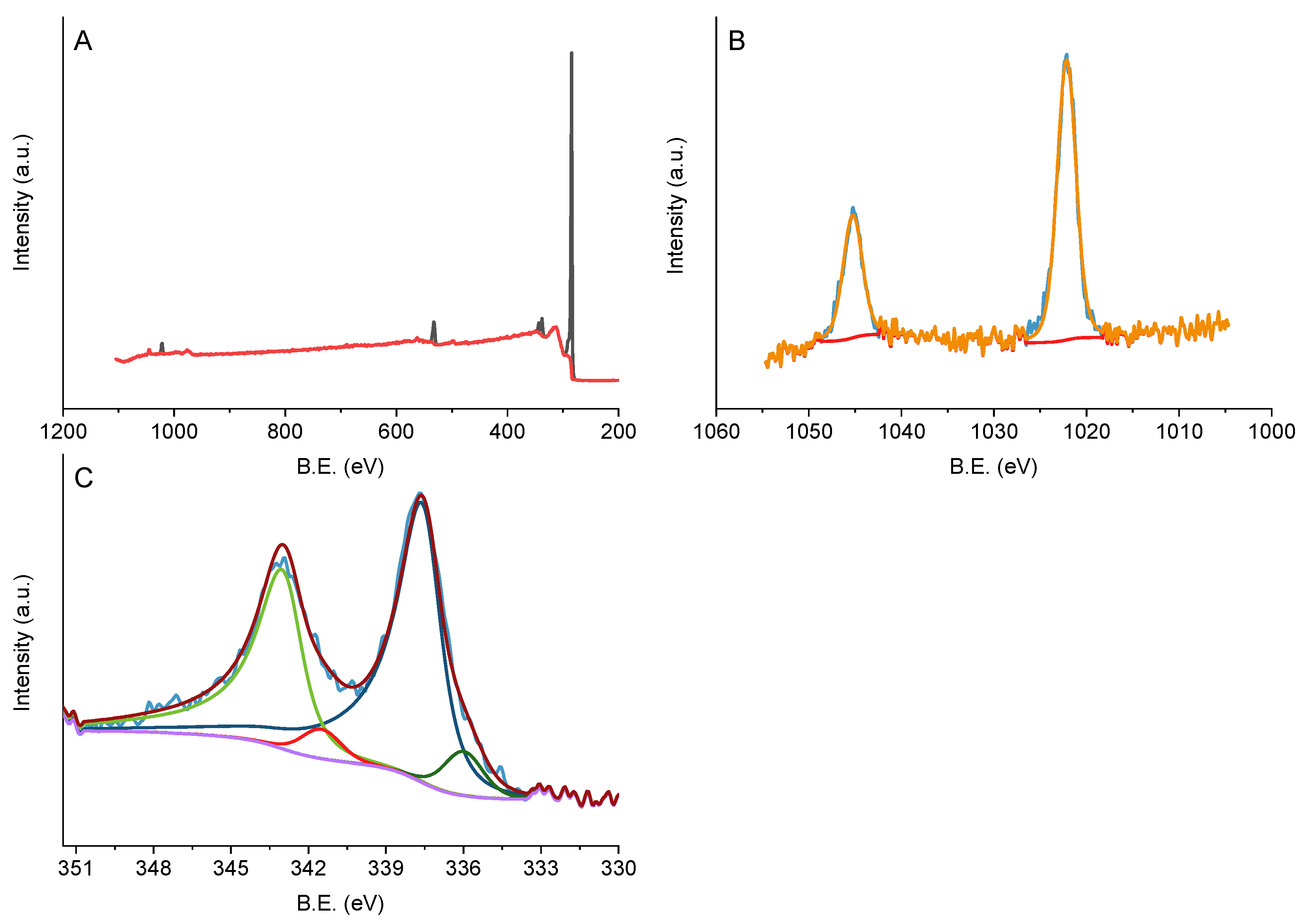
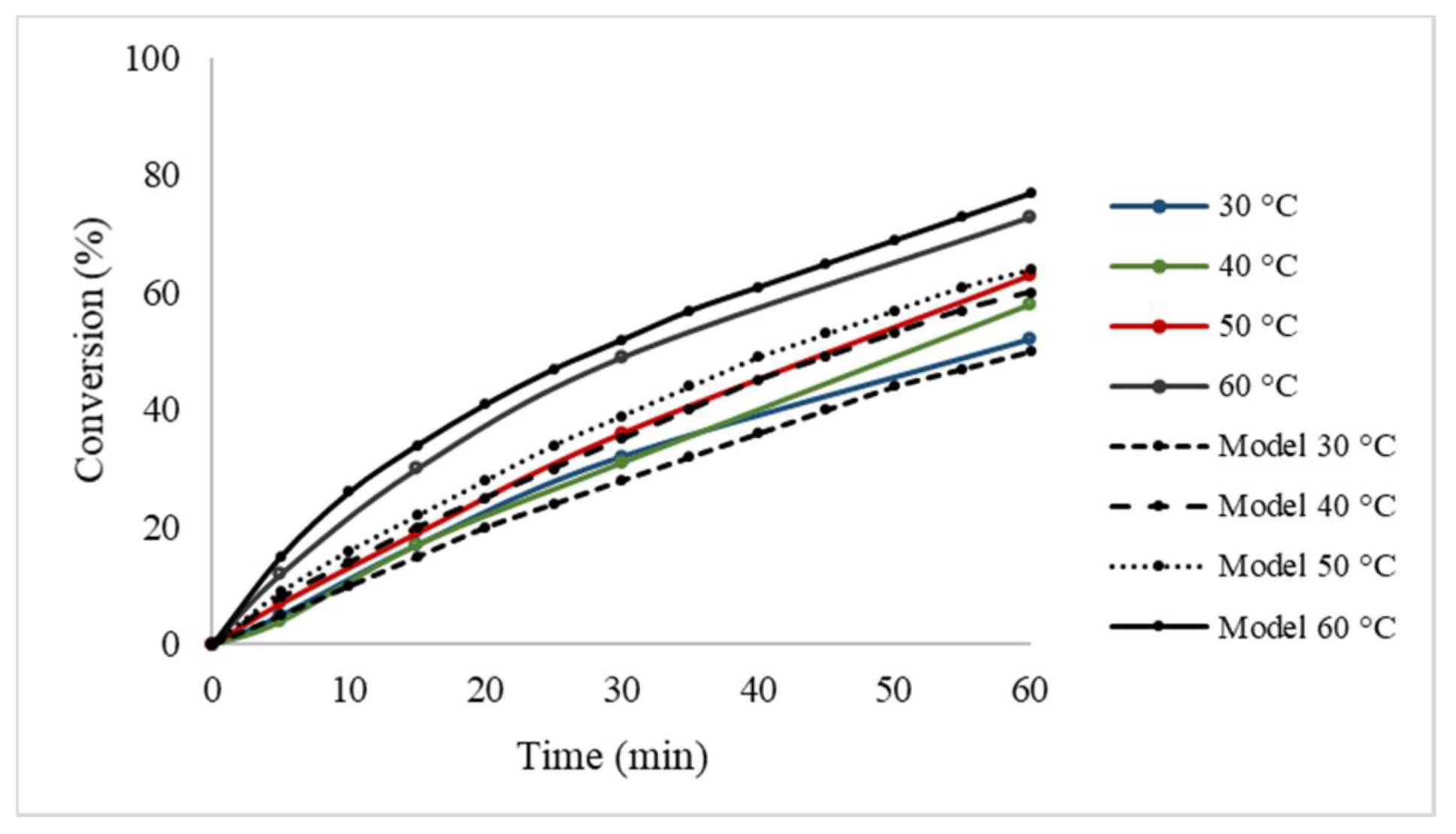
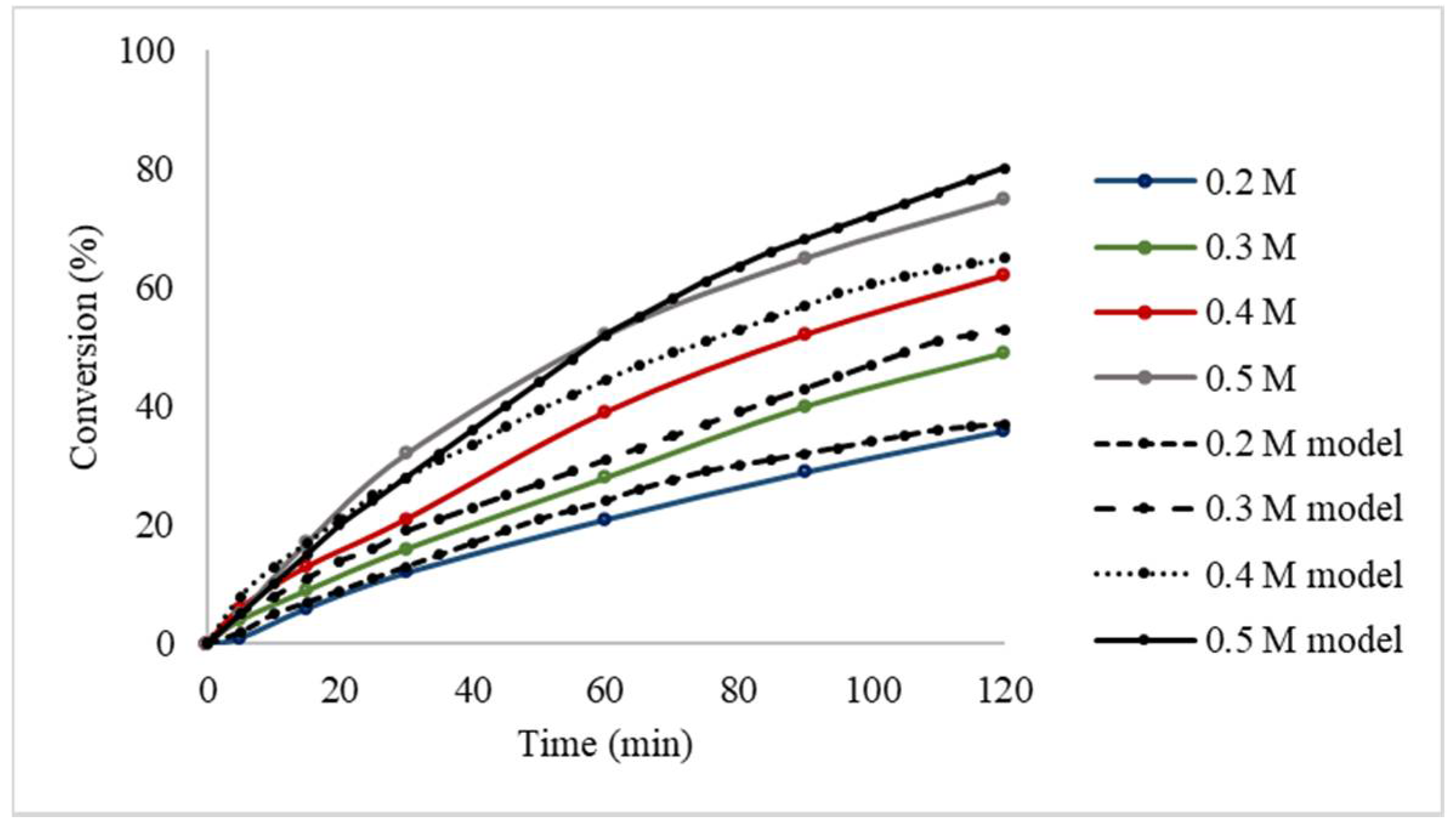
| Survey | Pd 3d | Zn 2p | Pd/Znnom | Pd/ZnXPS | Pd/ZnEDX | ||||||
|---|---|---|---|---|---|---|---|---|---|---|---|
| C 1s | O 1s | Pd 3d | Zn 2p | Pd(0) | Pd(II) | Zn(II) | |||||
| Pd6Zn4/HHT | B.E. (eV) | 284.5 | 532.6 | 337.6 | 1021.6 | 336.0 | 337.6 | 1022.1 | |||
| % At. | 95.6 | 3.6 | 0.6 | 0.1 | 9 | 91 | 100 | 1.5 | 6.0 | 6.1 | |
| X (%) | |||||
|---|---|---|---|---|---|
| Time (min) | 2% Pd6Zn4 Model | 2% Pd6Zn4 Exp | 5% Pd/C Model | 5% Pd/C Exp | 1% Pd Exp |
| 0 | 0 | 0 | 0 | 0 | 0 |
| 5 | 5 | 5 | 3 | 5 | 4 |
| 15 | 15 | 17 | 9 | 10 | 7 |
| 30 | 28 | 32 | 17 | 16 | 11 |
| 60 | 52 | 52 | 30 | 30 | 18 |
| 90 | 68 | 65 | 40 | 40 | - |
| 120 | 80 | 75 | 49 | 46 | 31 |
Publisher’s Note: MDPI stays neutral with regard to jurisdictional claims in published maps and institutional affiliations. |
© 2021 by the authors. Licensee MDPI, Basel, Switzerland. This article is an open access article distributed under the terms and conditions of the Creative Commons Attribution (CC BY) license (https://creativecommons.org/licenses/by/4.0/).
Share and Cite
Hafeez, S.; Barlocco, I.; Al-Salem, S.M.; Villa, A.; Chen, X.; Delgado, J.J.; Manos, G.; Dimitratos, N.; Constantinou, A. Experimental and Process Modelling Investigation of the Hydrogen Generation from Formic Acid Decomposition Using a Pd/Zn Catalyst. Appl. Sci. 2021, 11, 8462. https://doi.org/10.3390/app11188462
Hafeez S, Barlocco I, Al-Salem SM, Villa A, Chen X, Delgado JJ, Manos G, Dimitratos N, Constantinou A. Experimental and Process Modelling Investigation of the Hydrogen Generation from Formic Acid Decomposition Using a Pd/Zn Catalyst. Applied Sciences. 2021; 11(18):8462. https://doi.org/10.3390/app11188462
Chicago/Turabian StyleHafeez, Sanaa, Ilaria Barlocco, Sultan M. Al-Salem, Alberto Villa, Xiaowei Chen, Juan J. Delgado, George Manos, Nikolaos Dimitratos, and Achilleas Constantinou. 2021. "Experimental and Process Modelling Investigation of the Hydrogen Generation from Formic Acid Decomposition Using a Pd/Zn Catalyst" Applied Sciences 11, no. 18: 8462. https://doi.org/10.3390/app11188462






